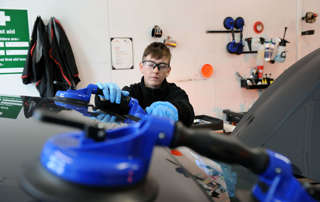Around a third (30%) of motorists feel uneasy at the prospect of driverless cars and fear they could be dangerous, according to research by Autoglass.
A further two-thirds (67%) of the 2,000 UK drivers surveyed cite safety concerns as their main deterrent for buying a driverless car in the future. More than half (54%) say they would feel unsafe riding in one.
However, a new report from Autoglass entitled ‘Window to the Future’ highlights that the opposite is true for many of the emerging technologies, whose cutting edge safety features will eventually transform the way that we drive.
Some of this technology has already been integrated into existing vehicle models. For instance, drivers can already purchase cars with ‘smart’ windscreens.
Looking further ahead, experts say that the smart windscreen will evolve into a new augmented reality version. Its functionality will aid the driving experience by alerting motorists to potential hazards, pedestrians, other vehicles or adverse weather conditions – mostly controlled through head-up display technology tracking the driver’s eye movement.
Although half (50%) of the drivers surveyed say they do not know what head-up display is, many recognise that there will be useful perks to new windscreen technology when it becomes more widely available with improved night vision (47%), water repellent windscreens (37%) and digital shading (32%) at the top of drivers’ technology wishlists.
These new inventions will prompt a behaviour change for the way that drivers interact with their cars, with many functions relying on voice control for activation which will allow motorists to better concentrate on safe driving.
Just one in five (20%) of drivers say they regularly use the voice control functionality that is available on other smart devices, with around a third (34%) preferring to operate devices manually instead. A further quarter (27%) says they doubt the efficacy of voice control.
Dr Chris Davies, head of technical superiority at Autoglass said: “The car of the future is, in many respects, already here. We’re seeing more sophisticated technologies and features that have started to revolutionise the driving experience. Many of these, such as the head-up displays and eye tracking devices, are already delivering benefits where they are being used by the military and also in some commercial vehicles.
“Our research reveals that although many drivers have an understanding of what the car of the future will look like, they aren’t quite ready to try it out just yet and they still enjoy the physical act of driving. Over one quarter (27%) of people surveyed say that they wouldn’t buy a driverless car for that reason, and just one in 10 (or 12%) is excited at the prospect of owning one.
“Above all else, we’re talking about a major change in the way we use our cars, which will take time to adapt to – from both a regulatory and consumer perspective. A large part of the puzzle will be education, in order to demonstrate to drivers how these new technologies will make life easier and improve, rather than detract from, their individual driving experience.”
For more on windscreens of the future, click here.



















Dorn Williamson - 04/11/2014 19:24
I want a DRIVERLESS CAR ASAP! I understand about safety...August 29, 1987 I was hit HEAD-ON...had a SEVERE TRAUMATIC BRAIN INJURY...LOST the RIGHT-FIELD from BOTH EYES...my driving is LIMITED! WHEN I get a DRIVERLESS CAR I will be ABLE to go see my nephews play a baseball game...not able now...they live 120 miles away...in a DRIVERLESS CAR I will be able to because the DRIVERLESS CAR will see EVERYTHING! I don't care which DRIVERLESS CAR I get...just want a GREAT DEAL! I live in Melbourne, FL...DRIVERLESS CARS ARE LEGAL HERE!